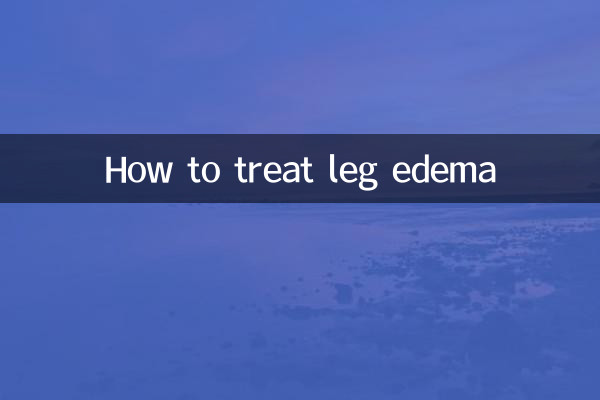How to Treat Leg Edema: Causes, Symptoms and Treatments
Leg edema is a common health problem for many people, especially those who sit or stand for long periods of time. In recent years, with the improvement of health awareness, the discussion about leg edema has gradually become a hot topic. This article will combine the hot content of the entire network in the past 10 days to conduct a detailed analysis from the causes, symptoms, diagnostic methods and countermeasures of leg edema, and attach structured data for reference.
1. Common causes of leg edema

Leg edema is usually caused by fluid retention in the body or poor blood circulation. The following are some of the most discussed reasons on the Internet:
| Reason type | Specific instructions | Discussion popularity (last 10 days) |
|---|---|---|
| Sitting and standing for long periods of time | Staying in the same position for a long time can impede blood circulation | high |
| eating habits | High-salt diet, insufficient drinking water, etc. | in |
| disease factors | Heart disease, kidney disease, varicose veins, etc. | high |
| Edema during pregnancy | Hormonal changes and uterine compression lead to | in |
| drug side effects | Certain antihypertensive or hormonal drugs | low |
2. Typical symptoms of leg edema
The symptoms of leg edema vary from person to person, but the following are the most common signs:
| Symptoms | Description | Severity |
|---|---|---|
| feeling of swelling | The legs become noticeably thicker and become sunken after being pressed | mild to severe |
| tight skin | Shiny or red skin surface | Mild |
| pain or numbness | accompanied by soreness or tingling sensation | moderate to severe |
| Restricted activities | Difficulty walking or bending | Severe |
3. How to diagnose leg edema
If leg edema persists, it is recommended to seek medical treatment in time. The following are common diagnostic methods:
| Diagnosis | Applicable situations | Remarks |
|---|---|---|
| Physical examination | Press the legs to observe the degree of depression | preliminary judgment |
| blood test | Check for kidney or heart problems | Requires hospital |
| Ultrasound examination | Check whether veins are blocked | Accurate diagnosis |
| Urine test | Assess kidney function | Auxiliary diagnosis |
4. Countermeasures for leg edema
According to the hot discussion on the Internet, the following methods are widely recommended:
| Coping methods | Specific operations | Effect evaluation |
|---|---|---|
| raise legs | Elevate your legs for 15-20 minutes every day | The effect is remarkable |
| Moderate exercise | Walking, yoga, etc. promote blood circulation | medium effect |
| diet modification | Reduce salt intake and eat more diuretic foods | Effective for a long time |
| Wear compression stockings | Choose socks with the right pressure level | short term relief |
| Massage | Gently massage from ankles to knees | instant relief |
5. When do you need medical treatment?
If leg edema is accompanied by the following conditions, it is recommended to seek medical attention immediately:
1.Sudden edema: Legs are obviously swollen in a short period of time with no obvious cause.
2.accompanied by other symptoms: Such as difficulty breathing, chest pain, fever, etc.
3.skin discoloration or ulcers: The skin on the legs turns purple or the wound does not heal.
4.Unilateral edema: Edema in only one leg may indicate deep vein thrombosis.
6. Tips to prevent leg edema
1.Avoid sitting and standing for long periods of time: Move for 5 minutes every hour to promote blood circulation.
2.Control salt intake: Daily salt intake should not exceed 6 grams.
3.exercise regularly: Swimming, brisk walking and other aerobic exercises have the best effect.
4.wear loose clothing: Avoid tight pants or socks that put pressure on your legs.
Through the above analysis, I hope everyone can understand leg edema more scientifically and take corrective measures in a timely manner. If symptoms persist or worsen, always consult a medical professional.

check the details

check the details